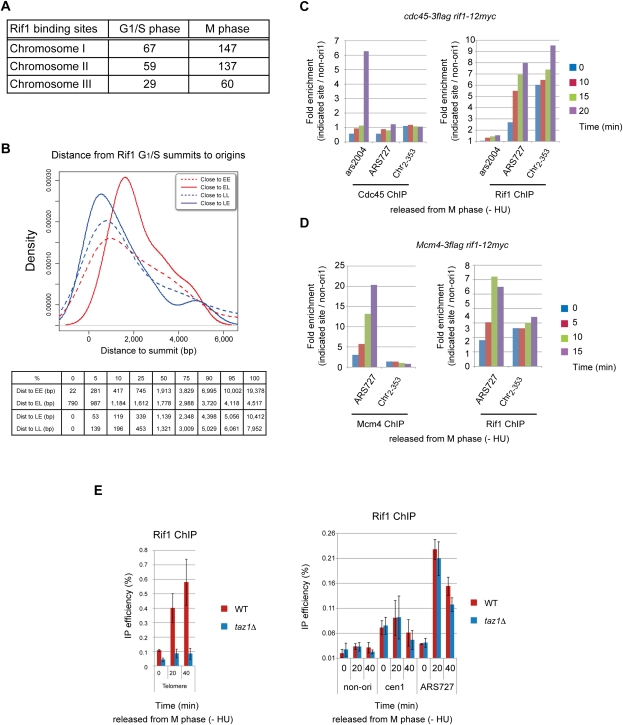Figure 6.
Rif1-BSs detected by ChIP–chip assays: cell cycle regulation and dependence on Taz1. (A) The numbers of Rif1-BSs on each chromosome are presented (total numbers: 155 BSs in G1/S and 344 in M phase). (B) Distribution of distances between Rif1-90min-BSs (Rif1-BSs in G1/S) and the closest ori plotted for each category of ori. (Broken red line) EE; (red line) EL; (broken blue line) LE; (blue line) LL. The table below shows the distribution (quantiles) of distances between Rif1-90min-BSs and the closest ori, summarized for each category. The size in each column shows the maximum distance for the fraction indicated to be contained; 50% corresponds to median value. (C,D) Dually tagged cells (cdc45-3Flag rif1-12myc [C] and mcm4-3Flag rif1-12myc [D]) were arrested in M phase and synchronously released into G1–S phase in the absence of HU. After harvest, cells were split into two parts, and Cdc45 and Rif1 (C) or Mcm4 and Rif1 (D) were immunoprecipitated with anti-Flag antibody or anti-Myc antibody, respectively. Cdc45-, Mcm4-, and Rif1-binding DNA were amplified with primer sets of non-ori1 (not bound by Mcm4 or Rif1), ars2004 (early-firing origin), ARS727 (late-firing origin bound by Rif1), and Chr2–353 (a non-ori bound by Rif1 but not by Mcm4). (E) Rif1-12myc cells in the wild-type or taz1Δ background arrested in M phase at 20°C were released into the cell cycle at 30°C in the absence of HU. Binding of Rif1 at TEL (the telomere sequence close to telomere repeats) (left) and at arm regions (including centromeres and dormant origins) (right) was quantified at each time point after release. ARS727 is described in the legend for Figure 3. (cen1) Centromere core regions on chromosome I.

